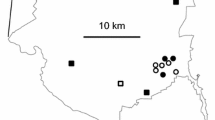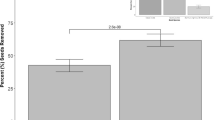Abstract
Biotic resistance is commonly invoked to explain why many exotic plants fail to thrive in introduced ranges, but the role of seed predation as an invasion filter is understudied. Abiotic conditions may also influence plant populations and can interact with consumers to determine plant distributions, but how these factors jointly influence invasions is poorly understood. In central Argentina’s Caldenal savannas, we experimentally examined how seed predation and water availability influenced recruitment/establishment of nine exotic plant invaders over 2 years. We then explored how seed predation patterns related to invasion patterns. Excluding rodent seed predators dramatically increased seedling recruitment for eight of nine exotic species (by 100–300 % in most cases) and increased young/adult plant abundance for four species in one or both years. Adding water to ameliorate drought tended to increase seedling numbers for most species, but these trends were not significant. Vegetation surveys revealed that exotic plant richness was 50 % lower in matrix habitat compared with disturbed roadsides and that cover of the two most aggressive invaders, which were both strongly suppressed by seed predation, was 75–80 % lower in matrix than roadside habitats. Seed offerings indicated seed removal by rodents was 11 times greater in intact matrix habitat compared with roadsides. Rodent seed predation represents a significant source of biotic resistance to plant invasions. Ubiquitous disturbances such as road construction can disrupt this filter. The widely recognized role that disturbance plays in facilitating invasions, which is largely attributed solely to reduced plant competition, may also arise from disruption of top–down controls.





Similar content being viewed by others
References
Alba-Lynn C, Henk S (2010) Potential for ants and vertebrate predators to shape seed-dispersal dynamics of the invasive thistles Cirsium arvense and Carduus nutans in their introduced range (North America). Plant Ecol 210:291–301
Allington GRH et al (2013) Niche opportunities and invasion dynamics in a desert annual community. Ecol Lett 16:158–166
Bartholomew B (1970) Bare zones between California shrub and grassland communities: the role of animals. Science 170:1210–1212
Blaney CS, Kotanen PM (2001) Post-dispersal losses to seed predators: an experimental comparison of native and exotic old field plants. Can J Bot 79:284–292
Brown JH, Heske EJ (1990) Control of a desert–grassland transition by a keystone rodent guild. Science 250:1705–1707
Brown JH, Lieberman GA (1973) Resource utilization and coexistence of see-eating desert rodents in sand dune habitats. Ecology 54:788–797
Cano E (1980) Inventario integrado de los recursos naturales de la provincia de La Pampa. INTA-UNLPam, Buenos Aires, Argentina (In Spanish)
Carrillo-Gavilán MA et al (2010) Comparing seed removal of 16 pine species differing in invasiveness. Biol Invasions 12:2233–2242
Carrillo-Gavilán MA et al (2012) Establishment constraints of an alien and a native conifer in different habitats. Biol Invasions 14:1279–1289
Chiuffo M (2009) Efecto de las picadas y caminos en la invasion de especies herbaceas en la reserva provincial Parque Luro. Undergraduate’s Thesis, Universidad Nacional de La Pampa, Santa Rosa, Argentina
Cushman JH et al (2011) Native herbivores and plant facilitation mediate the performance and distribution of an invasive exotic grass. J Ecol 99:524–531
Davis MA et al (2000) Fluctuating resources in plant communities: a general theory of invasibility. J Ecol 88:528–534
DeWalt SJ et al (2004) Natural-enemy release facilitates habitat expansion of the invasive tropical shrub Clidemia hirta. Ecol 85:471–483
Eckberg JO et al (2012) Insect herbivory and propagules pressure influence Cirsium vulgare invasiveness across the landscape. Ecology 93:1787–1794
Edwards GR, Crawley MJ (1999) Rodent seed predation and seedling recruitment in mesic grassland. Oecologia 118:288–296
Ellis BA et al (1998) Dietary habits of the common rodents in an agroecosystem in Argentina. J Mammal 79:1203–1220
Elton C (1958) The ecology of invasions by animals and plants. The University of Chicago Press, Chicago
Eriksson O, Ehrlen J (1992) Seed and microsite limitation of recruitment in plant populations. Oecologia 91:360–364
Ferreira AV et al (2011) Seed predators limit plant recruitment in Neotropical savannas. Oikos 120:1013–1022
Gelbard JL, Belnap J (2003) Roads as conduits for exotic plant invasions in a semiarid landscape. Conserv Biol 17:420–432
Giannoni SM et al (2005) Main food categories in diets of sigmodontine rodents in the Monte (Argentina). Mast Neotrop 12:181–187
Hierro JL et al (2009) Germination responses of an invasive species in native and non-native ranges. Oikos 118:529–538
Hierro JL et al (2011) Resistance to Centaurea solstitiatis invasion from annual and perennial grasses in California and Argentina. Biol Invasions 13:2249–2259
Inouye RS et al (1980) Effects of predation and competition on survivorship, fecundity, and community structure of desert annuals. Ecology 61:1344–1351
Kelt DA et al (1984) Seed predation by birds and small mammals in semiarid Chile. Oikos 104:133–141
Lambrinos JG (2006) Spatially variable propagule pressure and herbivory influence invasion of chaparral shrubland by an exotic grass. Oecologia 147:327–334
Levine JM et al (2004) A meta-analysis of biotic resistance to exotic plant invasions. Ecol Lett 7:975–989
Louda SM (1982) Variation in plant recruitment over a gradient in relation to insect seed predation. Ecol Monogr 52:25–41
Louda SM (1983) Seed predation and seedling mortality in the recruitment of a shrub, Haplopappus venetus (Aseraceae), along a climatic gradient. Ecology 64:511–521
Louda SM, Rodman JE (1996) Insect herbivory as a major factor in the shade distribution of a native crucifer (Cardamine cordifolia A. Gray, Bittercress). J Ecol 84:229–237
Mack RN (1996) Biotic barriers to plant naturalization. In: Moran VC, Hoffmann JH (eds) Proceedings of the IX international symposium on biological control of weeds. University of Cape Town Stellenbosch, South Africa, pp 39–46
Mares MA, Rosenzweig ML (1978) Granivory and North and South American deserts: rodents, birds, and ants. Ecology 59:235–241
Maron JL, Crone EC (2006) Herbivory: effects on plant abundance, distribution, and population growth. Proc R Soc B 273:2575–2584
Maron JL, Kauffman MJ (2006) Habitat-specific impacts of multiple consumers on plant population dynamics. Ecology 87:113–124
Maron JL, Simms EL (2001) Rodent-limited establishment of bush lupine: field experiments on the cumulative effect of granivory. J Ecol 89:578–588
Maron JL et al (2012) Seed size and provenance mediate the joint effects of disturbance and seed predation on community assembly. J Ecol 100:1492–1500
Mills JN et al (1992) Reproductive characteristics of rodent assemblages in cultivated regions of central Argentina. J Mammal 73:515–526
Mitchell CE, Power AG (2003) Release of invasive plants from fungal and viral pathogens. Nature 421:625–627
Mittelbach GG, Gross KL (1984) Experimental studies of seed predation in old-fields. Oecologia 65:7–13
Nuñez MA et al (2008) Seed predation as a barrier to alien conifer invasions. Biol Invasions 10:1389–1398
Orrock JL et al (2006) See predation, not seed dispersal, explains the landscape-level abundance of an early-successional plant. J Ecol 94:838–845
Orrock JL et al (2008) Apparent competition with an exotic plant reduces native plant establishment. Ecology 89:1168–1174
Ortega YK et al (2012) Population-level compensation impedes biological control of an invasive forb and indirect release of a native grass. Ecology 93:783–792
Ostfeld RS et al (1997) Effects of rodents on survival of tree seeds and seedlings in invading old fields. Ecology 78:1531–1542
Parker JD et al (2006) Opposing effects of native and exotic herbivores on plant invasions. Science 311:1459–1461
Pearson DE, Callaway RM (2008) Weed biocontrol insects reduce native plant recruitment through second-order apparent competition. Ecol Appl 18:1489–1500
Pearson DE, Fletcher RJ Jr (2008) Mitigating exotic impacts: restoring native deer mouse populations elevated by an exotic food subsidy. Ecol Appl 18:321–334
Pearson DE et al (2011) Biotic resistance via granivory: establishment by invasive, naturalized and native asters reflects generalist preference. Ecology 92:1748–1757
Pearson DE et al (2012) Biotic resistance: exclusion of native rodent consumers releases populations of a weak invader. J Ecol 100:1383–1390
Pierson EA, Mack RN (1990) The population biology of Bromus tectorum in forests: distinguishing the opportunity for dispersal from environmental restriction. Oecologia 84:519–525
Reader RJ (1993) Control of seedling emergence by ground cover and seed predation in relation to seed size for some old-field species. J Ecol 81:169–175
SAS Institute (2009) SAS/STAT User’s Guide, Version 9.2. SAS Institute Inc., Cary
Shahid A et al (2009) Selection of seeds of common native and non-native plants by granivorous rodents in the northeastern United States. Am Mid Nat 162:207–212
Shea K et al (2005) Context-dependent biological control of an invasive thistle. Ecol 86:3174–3181
Smith SE et al (2000) Geographic variation in predictive seedling emergence in a perennial desert grass. J Ecol 88:139–149
Troiani H, Steibel P (2008) Reconocimiento de malezas: Región subhúmeda y semiárida pampeana. Universidad Nacional de La Pampa, Colegio de Ingenieros Agrónomos de La Pampa, Santa Rosa (In Spanish)
Vilá M, Gimeno I (2003) Seed predation of two alien Opuntia species invading Mediterranean communities. Plant Ecol 167:1–8
Williamson MH, Fitter A (1996) The characters of successful invaders. Biol Conserv 78:163–170
Yahnke CJ et al (2001) Patterns of infection with Laguna Negra virus in wild populations of Calomys laucha in the central Paraguayan Chaco. Am J Trop Med Hyg 65:768–776
Zwolak R et al (2010) Fire and mice: seed predation moderates fire’s influence on conifer recruitment. Ecology 91:1124–1131
Acknowledgments
We thank B. Connolly, A. Litt, Y. Ortega, and anonymous reviewers for valuable feedback on draft manuscripts. L. S. Baggett consulted on statistical analyses. We are in debt to R. Lecitra, F. Miguel, N. Icasatti, and M. Cock for field assistance, and personnel at the Parque Luro Provincial Reserve for logistical support. Rainfall information for Santa Rosa was provided by G. Vergara (Agronomy Department, UNLPam). This project was funded by the President’s Early Career Award in Science and Engineering to D.E.P. and CONICET, ANPCyT, and UNLPam to J.L.H.
Author information
Authors and Affiliations
Corresponding author
Rights and permissions
About this article
Cite this article
Pearson, D.E., Hierro, J.L., Chiuffo, M. et al. Rodent seed predation as a biotic filter influencing exotic plant abundance and distribution. Biol Invasions 16, 1185–1196 (2014). https://doi.org/10.1007/s10530-013-0573-1
Received:
Accepted:
Published:
Issue Date:
DOI: https://doi.org/10.1007/s10530-013-0573-1




